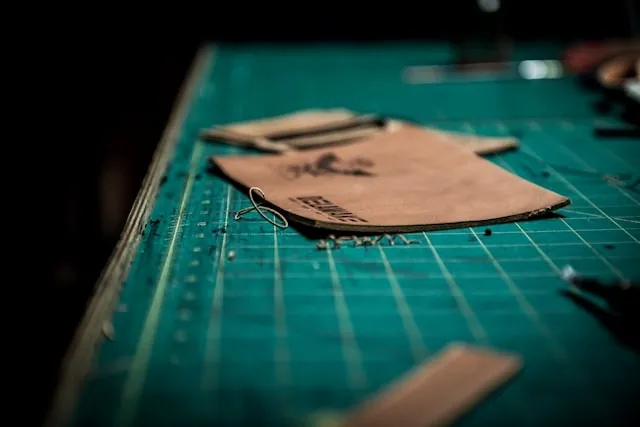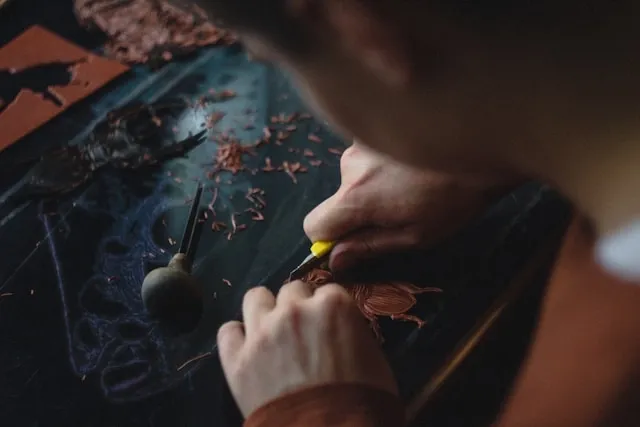How To Make Leather Patches For Hats (Step-By-Step Process)
With leather patches, you have a stylish and durable way to personalize hats. Whether you’re creating a custom design for your brand or for personal style, learning how to make leather patches for hats opens up many creative possibilities.
These patches can be engraved, embossed, or dyed, so your customization options are varied. In this guide, we walk you through a step-by-step process and explore other ways to create professional-looking leather patches. Read on to learn all you need to know.

Key Takeaways
- You need specific tools and techniques to craft leather patches, from cutting and engraving to achieving a secure attachment.
- High-quality leather at the right thickness is crucial for both durability and aesthetic appeal with your patches.
- There are various customization options like dyeing, embossing, or engraving to allow you to create unique patches.
- We supply high-quality custom leather patches that you can personalize for a variety of uses and even order in bulk to access generous wholesale discounts.
Table of contents
-
How To Make Leather Patches For Hats
-
What Tools Do You Need To Make Leather Patches
-
How To Attach Leather Patches To Hats?
-
What Kind Of Leather Do You Use For Hat Patches?
-
What Are The Best Materials For Making Leather Patches?
-
How To Sew Leather Patches?
-
How To Laser Cut And Engrave Leather Patches
-
How To Dye And Customize Leather Patches?
How To Make Leather Patches For Hats
To make leather patches for hats, you should follow a specific process that involves several key stages. Here is a step-by-step guide for you to follow:
- The material: Begin by selecting the right leather for your needs. Do your research to get this right.
- Cutting: Next, cut the leather into the desired shape. You should use a cutting mat and a sharp blade to do this with precision.
- Add the design: With the right patch shape, you are ready to use a laser cutter or engraving tool to add your custom design, which might include text or a logo.
- Finish: After engraving, you should smooth the patch edges with sandpaper to give it a clean finish.
- (Optional) Dye the patch: This will change the patch color to make it match your intended attachment location.
- Seal: Finally, seal the patch with an appropriate protective coat.
If you are a beginner, it is essential to practice these techniques on scrap leather first. Alternatively, you could order custom leather patches from us to get professional results at competitive prices.

What Tools Do You Need To Make Leather Patches
To make leather patches, you need several essential tools to help you customize and finish the leather and make your patch look its best. Here are some key ones:
- Laser cutter: This is crucial for precision cutting and intricate engraving.
- Rotary blade/sharp knife: Use this in combination with a cutting mat to trim the leather into the desired shape.
- Sandpaper: This is used to smooth the edges after cutting.
- Dye: Leather dye and brushes are required if you intend to color the leather.
Optional tools include embossing tools and a leather punch. You will also need tools for attaching your patch to your hat. To glue patches to fabric, you will need an appropriate fabric glue, for example. Understand the anatomy of leather to comprehend how to work with it.
Safety Measures To Follow While Making Leather Patches For Hats
Safety is a crucial consideration when learning how to make leather hat patches. Here are some key tips to follow, whether you are making patches for hats or custom natural cotton canvas tote bags:
- Laser cutters require careful handling and proper ventilation to avoid injury or inhaling fumes from the burned leather.
- You should wear protective eyewear at all times when using a laser cutter or engraving tool so your eyes are shielded from debris.
- If you cut leather with blades, use a cutting mat and cut away from your body to avoid injuries.
- When working with dyes or adhesives, wear gloves to avoid irritating your skin.
- Organize your workspace carefully and ensure sharp tools are safely stored when you aren’t using them.
Never overlook the importance of good safety practices. This way, you will ensure a more efficient crafting process as well as minimize the risk of injury or illness when working.
Want to make a statement with your team's apparel?
Enhance your uniforms with our custom patches!
Order now and create unique uniforms with our high-quality, personalized patches.
How To Attach Leather Patches To Hats?
There are several methods for how to put a patch on a hat, and leather requires a few specific considerations. Let’s look at the most common ones for you to explore:
- Sewing: This is a popular and secure method, particularly with thick leather patches. You will need a leather needle and some heavy-duty thread to achieve a strong bond.
- Iron-on: You could apply a heat-activated adhesive to the back of the leather for a quicker attachment process. Apply heat with an iron and press firmly onto the hat for a few seconds to activate the adhesive.
- Gluing: You could use a strong, leather-friendly adhesive glue to affix the patch.
- Velcro: You could choose a two-part Velcro strip that attaches to the hat and the rear of the patch for a temporary, replaceable attachment.
Whatever method you choose to use, make sure the patch is centered and firmly attached to prevent peeling or shifting over time.

What Kind Of Leather Do You Use For Hat Patches?
When you are making leather patches for hats, your best choice is vegetable-tanned leather as it is extremely durable and excellent for holding engravings and dye. Vegetable tanning is considered to be more environmentally friendly than traditional chrome tanning, and it becomes more beautiful with age.
Full-grain leather is another good option as it retains the hide’s natural texture, delivering strength and character. These are helpful characteristics when you are creating your custom patches by yourself. You should avoid low-quality or synthetic leather as it tends to wear out quickly and doesn’t engrave well.
The quality of the leather you choose significantly impacts the look and longevity of the patch you create. Invest in high-quality materials or work with us to create custom leather patches with a professional finish. This way, you will add quality embellishments to your premium hats for the best possible results.
Stand out from the crowd with our unique designs
Customize your style with our patches!
Order now and make a statement
make your custom patchesWhat Are The Best Materials For Making Leather Patches?
The best materials for making leather patches include high-quality vegetable-tanned or full-grain leather, as they provide a durable and aesthetically pleasing base. But you will also need the following materials:
- Polyester thread: This is best for dew-on applications, as it is strong and resistant to wear over time.
- Adhesive: Choose a leather-specific glue to achieve a lasting bond for an adhesive application.
- Dyes: These may be an essential material for your chosen customization.
- Sandpaper: This is important for smoothing edges after cutting and engraving.
- Fabric backing: This could make your patch sturdier before you apply it.
Steer clear of fake leather and low-quality materials as these will not stand the test of time. We use only the highest-quality materials when creating leather patches for our customers. Take a look at our custom leather patches for jackets to see what you could achieve with our help. We offer fast turnaround times and generous bulk discounts as well.
What Thickness Of Leather Should I Use For A Hat?
Ideally, leather patches will be made from high-quality leather with a thickness of 2-3 leather ounces (0.8 - 1.2mm approx.). At this thickness, you will have the necessary sturdiness for the patch to keep its shape and durability without it being too heavy or bulky for the hat.
Thicker leather is, undeniably, more durable, but it may not conform well to the curved surface of a hat. This will mean it is harder to achieve a secure attachment. Thinner leather, meanwhile, may lack the durability for regular use and could wear out or even break in a relatively short time.
Choosing the right thickness of leather for your hat patches ensures a healthy balance between durability and comfort. This is how you make the patch suitable for a variety of hat styles and materials, and versatility really is an important consideration when creating custom patches.
How To Sew Leather Patches?
Learning how to sew a patch onto a garment is crucial for your leather patch-making journey. You will need a heavy-duty sewing machine fitted with a leather needle that can easily penetrate thicker materials. You will also need to set your machine to a lower speed so that you can maintain control, and install a 100% polyester thread for maximum strength and durability.
When sewing the patch on, use a straight or zigzag stitch, depending on the design. Sew carefully around the edges of the patch. You can further enhance the durability by reinforcing the corners with a few extra stitches.
Make sure you test your stitches on a piece of scrap leather before the actual application. This will enable you to check that the tension and stitch length are appropriate before you proceed with sewing the actual patch. It’s important to be a competent user of your sewing machine - if you are uncertain, consult a professional to carry out the application process on your behalf.
Add a personal touch with our custom patches
Express yourself with our wide range of designs
Order now and make it yours.
How To Laser Cut And Engrave Leather Patches
To laser cut leather patches, you must tailor the settings precisely to ensure clean cuts and detailed engravings. This starts with adjusting the cutter to the appropriate power level for the thickness of your leather. Generally speaking, you will use lower settings for engraving and slightly higher settings for cutting.
Use vector signs to guide the laser and always test first on a small piece of leather to check that you have the correct settings. When you are engraving, you will need to increase the speed of the laser to avoid burning the leather. Experiment with different depths until you achieve the desired look.
Once your design is cut and engraved, it’s an important final step to gently sand the edges for a polished finish. A laser cutter can create incredible precise and accurate cuts and engravings, but it does take some knowledge and expertise to use it properly.
How To Press Leather Patches Onto Hats?
If you want to press leather patches onto hats, you will need to educate yourself on how to iron on patches unless you have a heat press. Here’s a basic step-by-step for this process:
- Set the iron to a medium heat that is appropriate for your leather.
- Place the patch in your desired location, ensuring proper alignment and orientation.
- Cover it with a thin cloth or parchment paper so the leather is protected from direct heat.
- Apply firm, even pressure for 10-15 seconds, so that the heat bonds the adhesive to the hat.
- Allow it to cool fully before handling or wearing the hat.
If you don’t want to use an iron-on backing, you could apply specialized leather glue. Make sure you follow the instructions carefully to apply it - some people will even combine both for added security. This can be a simple and effective way to apply your leather patches to hats.

How To Dye And Customize Leather Patches?
Dyeing leather patches can give them a striking look and match their color to the hat or garment you plan to apply them to. The first step is to clean the leather surface before applying the dye evenly. Use a sponge of a brush to apply the dye in thin, even coats, ensuring each layer dries thoroughly before you add another.
You can customize the patch further by adding designs through things like:
- Stamping
- Embossing
- Painting
If you choose stamping, use metal stamps and a mallet to imprint stamps into the leather. Once dyeing and customizing are complete, seal the patch with a leather finish to protect against wear and tear. Proper sealing also helps preserve the vibrancy of the dye and maximize the patch’s longevity.
If you want professional results for customized leather hat patches without all the effort, use our reliable, affordable service to create your custom leather name patches.
Make a statement with our unique designs
Stand out with our custom patches!
Order now and show off your style
make your custom patchesFrequently Asked Questions About How To Make Leather Patches For Hats
How To Make Leather Patches For Hats Easily?
Making leather hat patches easily is all about getting the right leather, having the appropriate tools for cutting and engraving, and being prepared with your design, sandpaper, dyes, and leather sealant to make your vision a reality.
How To Attach Leather Patches To Hats?
To attach your leather patches to hats, you can use a sewing machine, apply an iron-on backing, or use a specialized leather fabric adhesive to create a strong attachment that will stand the test of time.